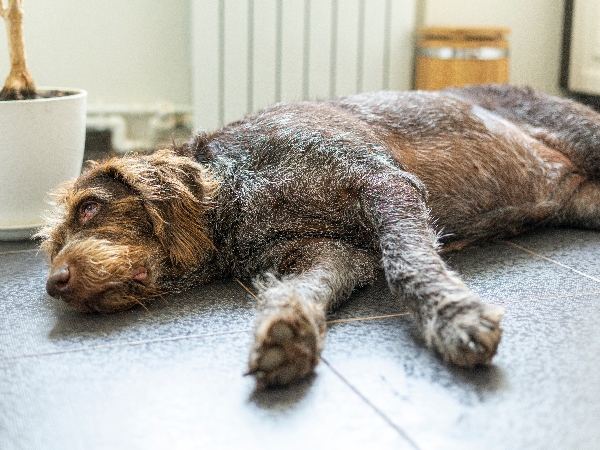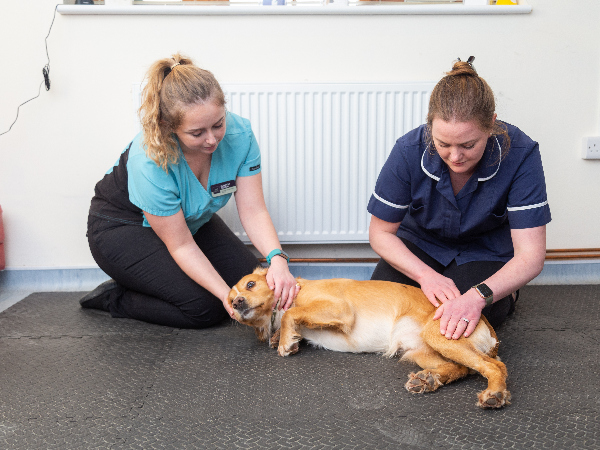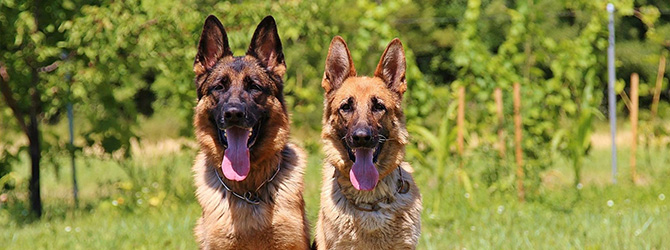Hip dysplasia in dogs: symptoms, treatment and prevention
First Published: 19/04/2023
Last Updated: 21/09/2023
Hip dysplasia in dogs is caused by a deformity in the hip and begins in puppyhood when the hip joint is growing quickly. When your puppy grows, the ball and socket joint must grow at the same speed. If it doesn't, then hip dysplasia can occur. As your dog ages, the cartilage and the bone will wear down, leading to arthritis, weakened muscles and limited mobility.
Brief summary
- Hip dysplasia is a condition in dogs caused by a deformity in the hip joint
- It is among the most commonly reported health issues for all dogs, affecting 22.3% of breeds
- Signs of hip dysplasia can include decreased activity, reluctance to stand up, reduced range of motion, bunny hopping, loss of muscle in thighs, and pain
- Hip dysplasia can be corrected with surgery
What is hip dysplasia in dogs?
Hip dysplasia is a painful condition where the hip joints don’t grow properly when your dog is a puppy. Dysplasia means 'abnormality of growth.' The hip joint is known as a ball and socket joint, where the head of the femur (the ball) fits into the hip cavity (the socket). In dogs without joint issues, this ball and socket will grow at the same pace and fit perfectly, giving the dog a full range of motion.
With hip dysplasia, the ball and socket grow at different speeds, and the ligaments that normally keep the joint stable become loose, meaning they don’t fit together well. Over time this will cause the head of the femur to flatten, making the fit even worse.
If your puppy has hip dysplasia they will experience slight pain as they grow. This can turn into arthritis, weakened muscles and limited mobility as they age. It can be corrected if caught early but will require surgery.
With proper care, a good diet and an understanding of their limitations, a dog with hip dysplasia can still lead a full and active life.
How common is hip dysplasia in dogs?
Research from the Royal Veterinary College into health issues for different breeds has found that hip dysplasia is among the most commonly reported health issues for all dogs. It found that hip dysplasia affected 22.3% of breeds, accounting for 1.9% of all reported conditions. Whilst that may seem worrying, it does mean that veterinarians are used to seeing, diagnosing and treating the condition.
What breeds are at the highest risk of hip dysplasia?
Hip dysplasia is a common condition in large and giant dogs and is more common in pedigree breeds, but can affect dogs of any size. Therefore, some breeds must be managed carefully to lower their risk.
German Shepherd
The German Shepard is known as the most at-risk breed for hip dysplasia. This is because they're large, powerful, active dogs which puts them at high risk of dysplasia. Even if your German Shepherd doesn't develop the condition, they will likely have mobility issues as they age.
Labrador

Labradors are large active dogs who just want to move. Unfortunately, their drive to be active can increase their chances of developing hip dysplasia. Combined with their well-documented food drive, the chances of them becoming overweight as they get older can increase the likelihood of potential issues arising.
Saint Bernard
The St Bernard is easily one of the world's largest dog breeds; because of this, there is already a lot of weight and pressure on their joints. You should feed your Saint Bernard a breed-weight-specific diet to keep them at a good weight and help reduce the pressure on their joints. .
Corgi
Although small and compact, hip dysplasia is a common problem in Corgis. Over-exercising, weight gain and rapid growth can all contribute to the condition.
Symptoms of hip dysplasia in dogs
You may see symptoms of hip dysplasia in your dog when they're as young as four months old, or it might not be clear they’re struggling until they get older. However, some symptoms of hip hip dusplasia in dogs can include:
- Decreased activity
- Reluctance to stand up, jump, run or walk up the stairs
- Reduced range of motion
- 'Bunny hopping' as they walk (bringing one or both legs up and hopping instead of walking)
- Loss of muscle in their thighs
- Increase in muscle around their shoulders (caused by an overreliance on their front end to walk)
- Pain
- Limping
Causes of hip dysplasia
Whilst we have discussed the physical cause of hip dysplasia, other factors can contribute.
Genetics
Hip dysplasia is a genetic condition mainly affecting medium and large pedigree dogs, such as German Shepherds and Golden Retrievers. However, it is not a congenital disability, meaning dogs aren’t born with bad hips. In fact, all puppies, regardless of breed, are born with 'normal' hips. It is only as they age that the genetic anomaly may make an appearance. Unfortunately, despite years of research, the genes responsible for the condition are still unknown. What is understood is that hip dysplasia is inherited through multiple genes, which suggests that it can be passed down through either or both parents. It’s also been found that the genes responsible are all breed-specific, so it's unlikely that a genetic solution will be found.
Body weight
Puppies that are heavier at birth and gain weight quicker are at higher risk of hip dysplasia, which is why it's most commonly seen in larger breeds. Unfortunately, canine obesity is on the rise and will contribute to increased diagnosis among all breeds. A study has shown that puppies on a restricted diet have a hugely reduced risk of hip dysplasia. However, you must speak with your vet before lowering or increasing your puppy's food. A well-balanced diet is integral to their physical and mental development.
Related article: How heavy should my dog be

Exercise
All dogs need exercise, but be wary of over-exercising your puppy. Puppies should generally only be exercised for around 10 minutes every month of age. So if your puppy is four months old, they can play for forty minutes before stopping and sleeping so they can recover. This is because they easily over-exercise and damage their fast-growing bones and joints.
You should also try to keep your puppy away from slippery surfaces when they're under three months old, as they aren't as steady on their feet and can easily overextend their joints. The same goes for stairs. For example, suppose you’re toilet training your puppy, and they have to go downstairs to the garden. In that case, you should carry them until they’re at least four months old to give the joints a chance to strengthen and support them.
When should I see my vet?
You should visit your vet regularly if you have an at risk breed. Together you can devise a plan that will help reduce the risk. Pet Health Club™ members can benefit from healthy pet checks every six months, allowing your vet and veterinary nurse to closely monitor how your dog is growing.
Diagnosing hip dysplasia in dogs
Your vet or veterinary nurse will conduct a physical exam during regular visits, which is often enough to diagnose possible hip dysplasia. During these check-ups, they will 'manipulate' your dog's hind legs, testing them for a range of movement, looseness in the joint, 'grinding' sounds and inflammation.
Your vet practice will also consider your dog's breed, age, lifestyle and possible injuries or accidents.
If your vet suspects your dog is suffering from hip dysplasia an x-ray may be taken. This allows your vet to determine how severe the condition is and a treatment plan can be put in place.
Treating hip dysplasia in dogs
There are two main treatment plans for hip dysplasia. Surgical or non-surgical treatment. If your dog's condition is minor, or surgery isn’t recommended because of age or medical issues, then your vet may suggest:
- Weight reduction and control
- Exercise changes or restrictions, especially around hard or slippery surfaces
- Physical therapy
- Supplements
- Anti-inflammatory medications
- Hydrotherapy
Most of these approaches will be life-long changes to your dog's lifestyle. Frequent visits to the vet will help control the condition and allow you to see how it's progressing.

Surgery
Related articles: A guide to veterinary referrals
If your dog has advanced hip dysplasia or it is severely affecting them, they may need surgery. Three types of surgery will be considered.
Double or triple pelvic osteotomy
This is usually performed on young dogs less than 10 months old. The surgeon will cut and rotate sections of the pelvic bone to improve the ball and socket joint.
Femoral head osteotomy
This surgery can be performed on all dogs and involves removing the ball part of the joint. This creates a 'false' joint, and whilst it won't give your dog normal hip function, it will reduce the pain and discomfort. Recovery time for femoral head osteotomy can be up to six months. Reports suggest that excellent results can be as low as 37%.
Total hip replacement
A total hip replacement replaces the ball and socket joint with a prosthetic implant with the same movement and function as the original joint. Generally, over 95% of dogs with hip replacements live pain-free and active lives without issues.
Preventing hip dysplaisia
Find a reputable breeder
The best prevention technique is to choose a breed with a low chance of inheriting the condition. For example, German Shepherds have a 1 in 5 chance of developing dysplasia, even higher if one of their parents has it.
However, if your heart is set on a dog that may develop dysplasia, then get them from a reputable breeder. Hopefully, they won't have been bred from a dog with clear signs of hip dysplasia, and you will be able to see if they have it when you visit. Always ensure you can meet both parents, regardless of the breed you hope to have. It is possible to have ‘hip scores’ for breeding dogs, this number can give an indication of whether the parents are likely to pass it on to their offspring. The higher the hip score, the more likely the parents (and offspring) will have the condition. There are recognised breed ‘normals’ to compare individual dogs to.
Related articles: Choosing a puppy breeder
You’ll know you’ve found a good dog breeder because they’ll:
- Spend time talking you through the breed on the phone and in person
- Have documented hip scores for both parents
- Arrange a time for you to visit and meet the litter and both parents. If they don’t show you either parent, don’t buy your puppy there.
- Allow you to visit more than once. Getting a dog is a big responsibility. You shouldn't be rushed
- Answer all your questions and ask some of their own to make sure the puppies are going to a good home.
- Show you vaccination status and flea and worm treatments.
A good dog breeder won’t
- Rush you into parting with money for your puppy
- Be unable or refuse to show you the mother. If they say they are out for a walk, at the vet, or working, there’s a strong chance you’re at an illegal puppy farm
- Meet you in a park or car park or deliver the puppy to your home. Always pick the dog up from the breeder
- Sell the puppy before they are 8 weeks old. This is illegal

Healthy diet
Weight gain can seriously impact a dog's well-being and increase the chances of hip dysplasia. Speak to your vet about the best diet for your dog and ensure that all treats and snacks are accounted for.
 Proper exercise
Proper exercise
Even if you have a high-energy dog, ensuring they're getting the right amount and type of exercise is crucial. When dogs are puppies, they can't exercise for long and are often not very good at knowing when to stop. Making sure you give your dog lots of breaks and time to sleep will help their bones and joints grow at the proper rate.
When walking your dog ensure you aren’t over walking them. Speak to your vet and develop an exercise plan that will keep your dog mobile, but won’t put too much pressure on their joints.
If your dog still has lots of energy and hip dysplasia stops them from going on long walks, brain games are a fantastic way of tiring them out. All dogs should have proper mental stimulation, especially working breeds. Not only does it engage their minds, but you'll also be surprised at how tired they get.
Joint supplements
Joint supplements can help reduce inflammation and slow down the progress of joint damage. They're a safe and valuable tool in preventing hip dysplasia and other common issues like arthritis. Before you give your dog joint supplements, speak with your vet and see what supplements are best and if they could help your dog.
Joint supplements generally work by:
- Acting as a natural anti-inflammatory. This soothes stiff joints, which will allow your dog to move around easier.
- Easing movement by keeping the fluid in the joint healthy
- Keeping the joint cartilage strong and smooth
Two of the most common ingredients in dog supplements are:
- Glucosamine: a compound that is found naturally in the body and plays a key role in making glycosaminoglycans and glycoproteins. These are some of the critical components of tendons, cartilage and ligaments
- Chondroitin: a significant component of cartilage and other connective tissues.
These work together to help the joint remain strong and mobile.
Common questions around hip dysplasia in dogs
How long can a dog live with hip dysplasia?
Hip dysplasia won't usually shorten your dog's life but you might have to make lifestyle changes to lessen its impact on your dog's health. These could be different diets, a different exercise regime, more mental stimulation and a greater understanding of how they're feeling day to day.
Should you walk a dog with hip dysplasia?
Yes. Walking your dog can help keep the muscles strong, to support the sore hip joints. Gentle walks that start and finish with small stretches will help your dog live a full and happy life.
What is end-stage hip dysplasia in dogs?
End-stage dysplasia is what will occur as your dog ages. They may become lame, struggle to sit and stand or be unable to walk as much and as far as they could when they were a pup. Finding different ways to stimulate your dog and letting them rest as much as they need to may be all you can do. Still, it shouldn't stop your dog from having a loving and peaceful later life. Working with your vet to determine the best pain relief regime for your dog is crucial at this stage in life.
Need more advice?
Find your nearest vet using our Find a Vet page, or speak to a vet online using Online Vets.

